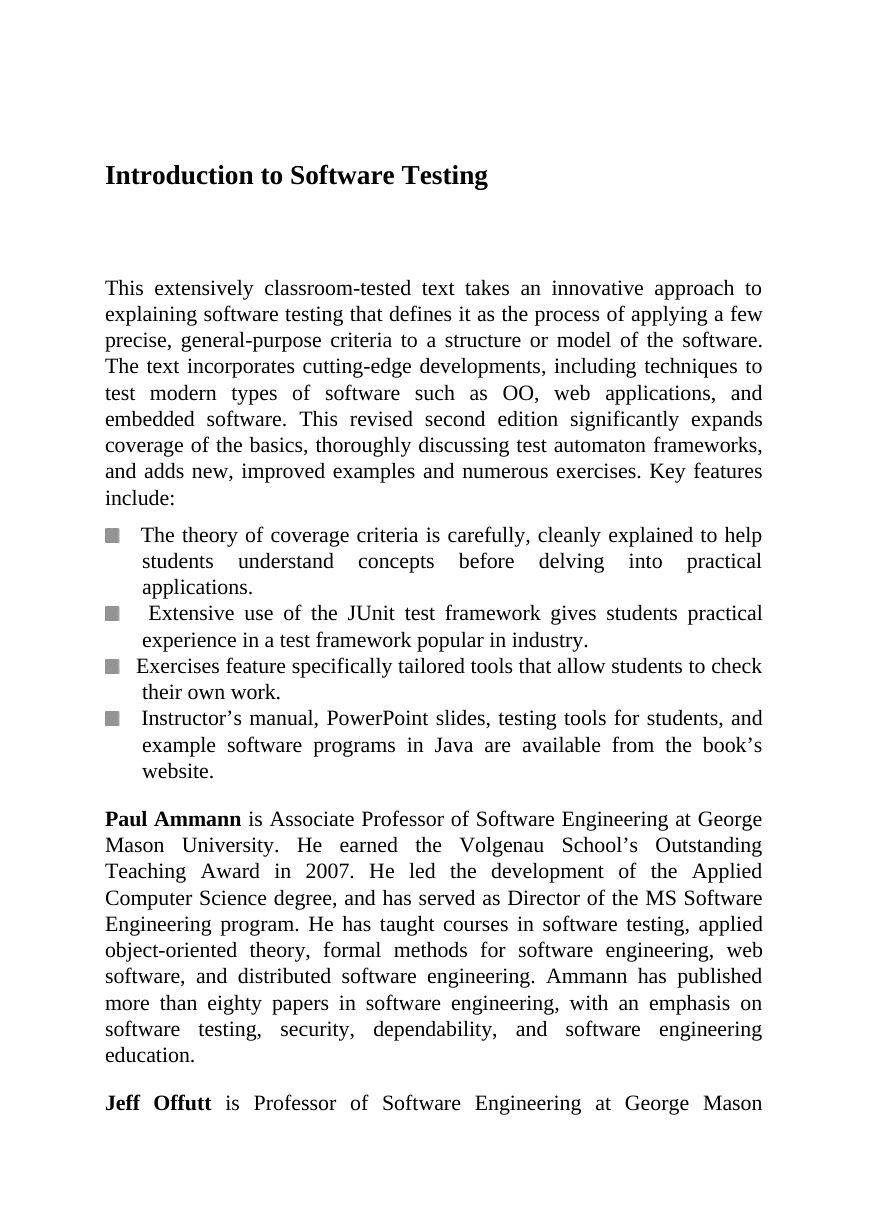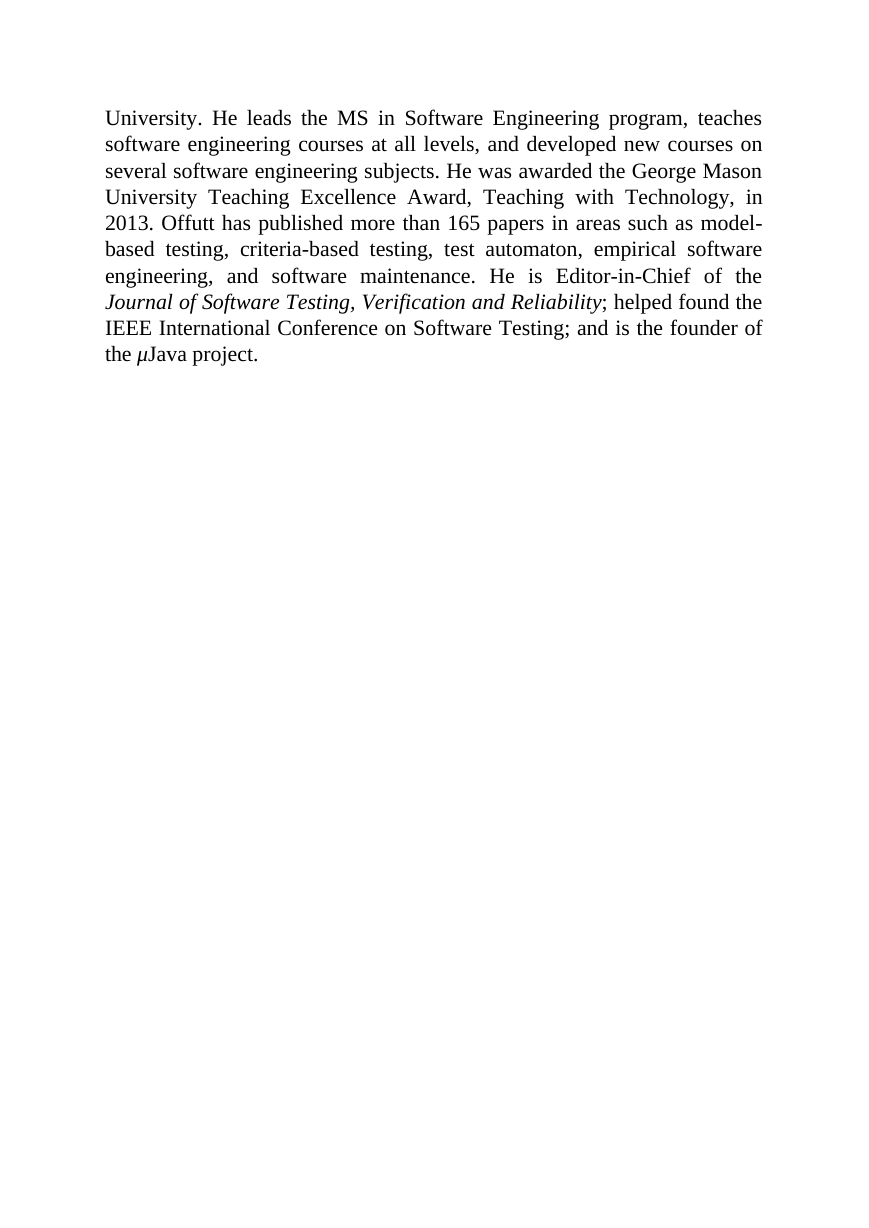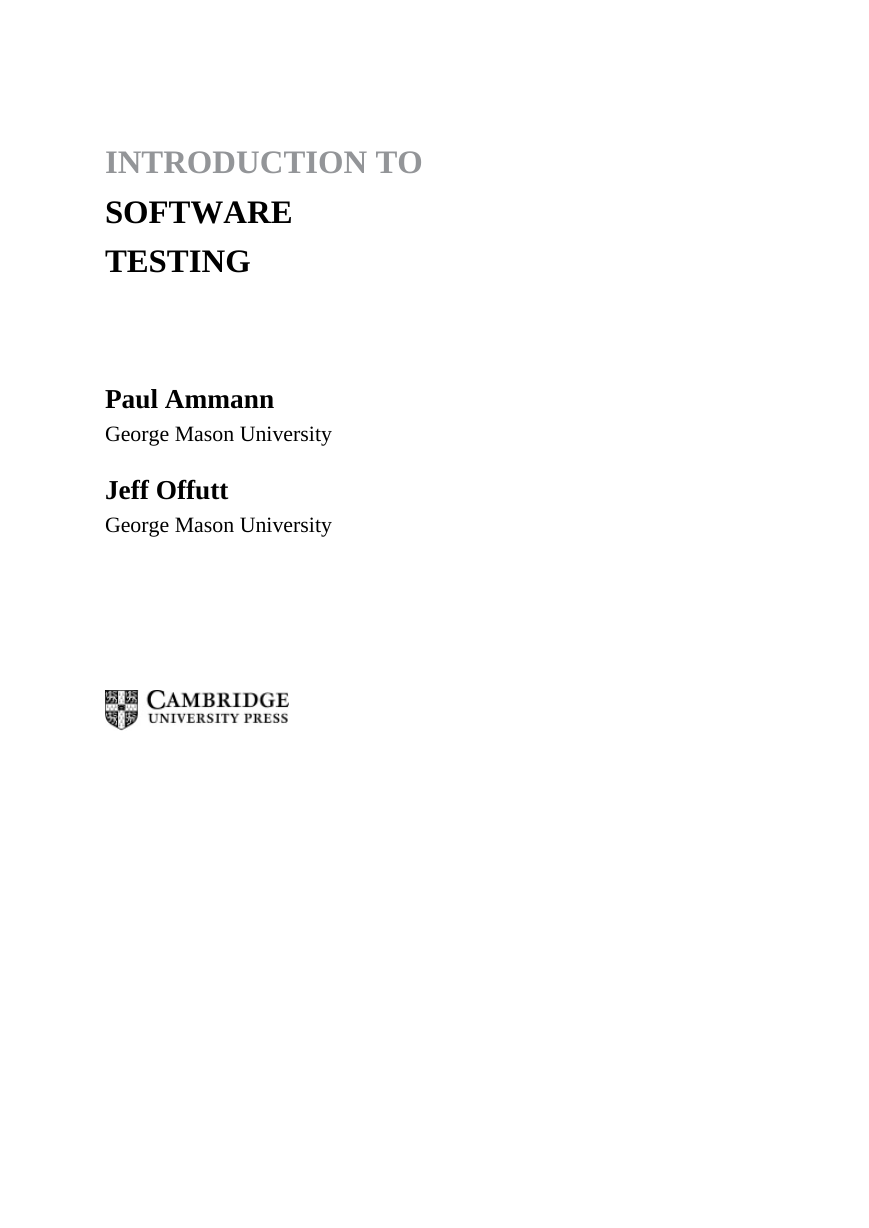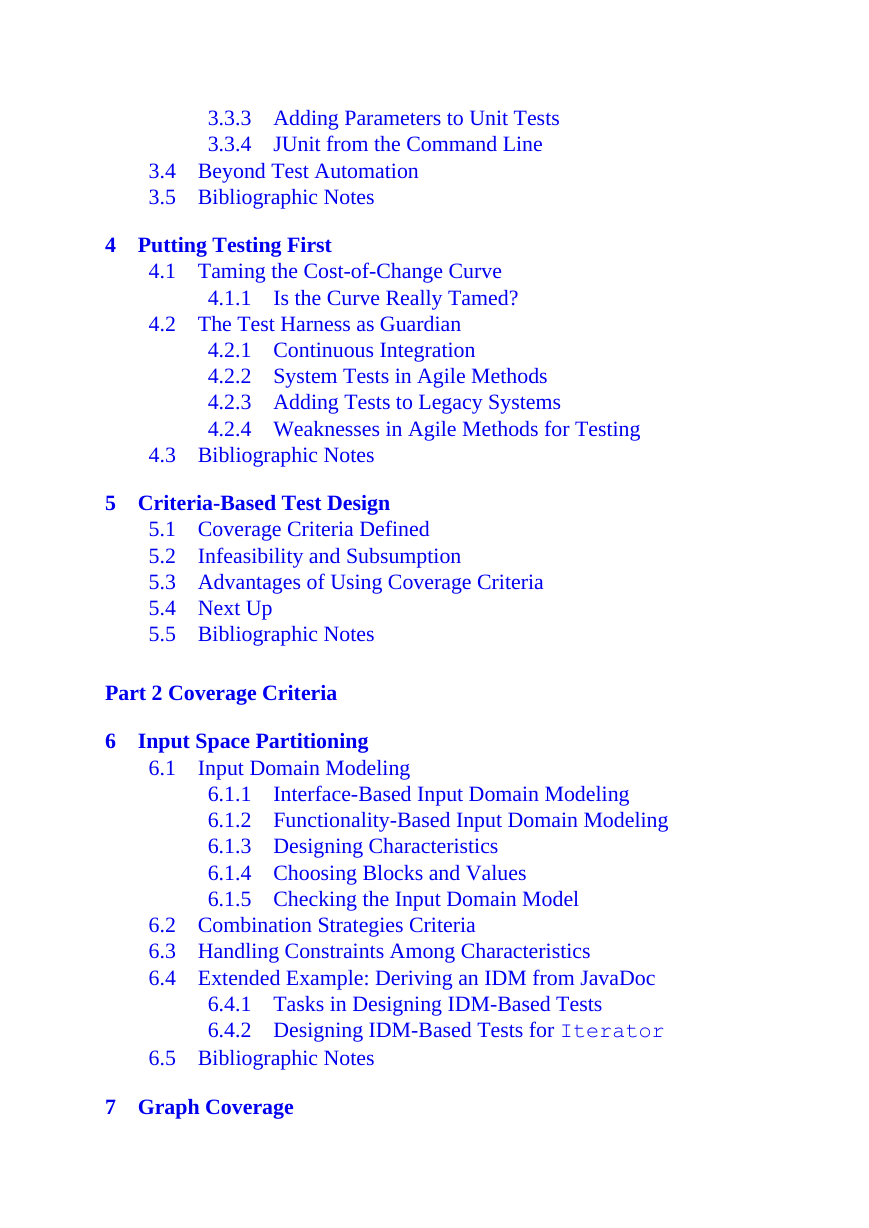Half-title
Title Page
Copyright Page
Contents
List of Figures
List of Tables
Preface to the Second Edition
Part 1 Foundations
1 Why Do We Test Software?
1.1 When Software Goes Bad
1.2 Goals of Testing Software
1.3 Bibliographic Notes
2 Model-Driven Test Design
2.1 Software Testing Foundations
2.2 Software Testing Activities
2.3 Testing Levels Based on Software Activity
2.4 Coverage Criteria
2.5 Model-Driven Test Design
2.5.1 Test Design
2.5.2 Test Automation
2.5.3 Test Execution
2.5.4 Test Evaluation
2.5.5 Test Personnel and Abstraction
2.6 Why MDTD Matters
2.7 Bibliographic Notes
3 Test Automation
3.1 Software Testability
3.2 Components of a Test Case
3.3 A Test Automation Framework
3.3.1 The JUnit Test Framework
3.3.2 Data-Driven Tests
3.3.3 Adding Parameters to Unit Tests
3.3.4 JUnit from the Command Line
3.4 Beyond Test Automation
3.5 Bibliographic Notes
4 Putting Testing First
4.1 Taming the Cost-of-Change Curve
4.1.1 Is the Curve Really Tamed?
4.2 The Test Harness as Guardian
4.2.1 Continuous Integration
4.2.2 System Tests in Agile Methods
4.2.3 Adding Tests to Legacy Systems
4.2.4 Weaknesses in Agile Methods for Testing
4.3 Bibliographic Notes
5 Criteria-Based Test Design
5.1 Coverage Criteria Defined
5.2 Infeasibility and Subsumption
5.3 Advantages of Using Coverage Criteria
5.4 Next Up
5.5 Bibliographic Notes
Part 2 Coverage Criteria
6 Input Space Partitioning
6.1 Input Domain Modeling
6.1.1 Interface-Based Input Domain Modeling
6.1.2 Functionality-Based Input Domain Modeling
6.1.3 Designing Characteristics
6.1.4 Choosing Blocks and Values
6.1.5 Checking the Input Domain Model
6.2 Combination Strategies Criteria
6.3 Handling Constraints Among Characteristics
6.4 Extended Example: Deriving an IDM from JavaDoc
6.4.1 Tasks in Designing IDM-Based Tests
6.4.2 Designing IDM-Based Tests for Iterator
6.5 Bibliographic Notes
7 Graph Coverage
7.1 Overview
7.2 Graph Coverage Criteria
7.2.1 Structural Coverage Criteria
7.2.2 Touring, Sidetrips, and Detours
7.2.3 Data Flow Criteria
7.2.4 Subsumption Relationships Among Graph Coverage Criteria
7.3 Graph Coverage for Source Code
7.3.1 Structural Graph Coverage for Source Code
7.3.2 Data Flow Graph Coverage for Source Code
7.4 Graph Coverage for Design Elements
7.4.1 Structural Graph Coverage for Design Elements
7.4.2 Data Flow Graph Coverage for Design Elements
7.5 Graph Coverage for Specifications
7.5.1 Testing Sequencing Constraints
7.5.2 Testing State Behavior of Software
7.6 Graph Coverage for Use Cases
7.6.1 Use Case Scenarios
7.7 Bibliographic Notes
8 Logic Coverage
8.1 Semantic Logic Coverage Criteria (Active)
8.1.1 Simple Logic Expression Coverage Criteria
8.1.2 Active Clause Coverage
8.1.3 Inactive Clause Coverage
8.1.4 Infeasibility and Subsumption
8.1.5 Making a Clause Determine a Predicate
8.1.6 Finding Satisfying Values
8.2 Syntactic Logic Coverage Criteria (DNF)
8.2.1 Implicant Coverage
8.2.2 Minimal DNF
8.2.3 The MUMCUT Coverage Criterion
8.2.4 Karnaugh Maps
8.3 Structural Logic Coverage of Programs
8.3.1 Satisfying Predicate Coverage
8.3.2 Satisfying Clause Coverage
8.3.3 Satisfying Active Clause Coverage
8.3.4 Predicate Transformation Issues
8.3.5 Side Effects in Predicates
8.4 Specification-Based Logic Coverage
8.5 Logic Coverage of Finite State Machines
8.6 Bibliographic Notes
9 Syntax-Based Testing
9.1 Syntax-Based Coverage Criteria
9.1.1 Grammar-Based Coverage Criteria
9.1.2 Mutation Testing
9.2 Program-Based Grammars
9.2.1 BNF Grammars for Compilers
9.2.2 Program-Based Mutation
9.3 Integration and Object-Oriented Testing
9.3.1 BNF Integration Testing
9.3.2 Integration Mutation
9.4 Specification-Based Grammars
9.4.1 BNF Grammars
9.4.2 Specification-Based Mutation
9.5 Input Space Grammars
9.5.1 BNF Grammars
9.5.2 Mutating Input Grammars
9.6 Bibliographic Notes
Part 3 Testing in Practice
10 Managing the Test Process
10.1 Overview
10.2 Requirements Analysis and Specification
10.3 System and Software Design
10.4 Intermediate Design
10.5 Detailed Design
10.6 Implementation
10.7 Integration
10.8 System Deployment
10.9 Operation and Maintenance
10.10 Implementing the Test Process
10.11 Bibliographic Notes
11 Writing Test Plans
11.1 Level Test Plan Example Template
11.2 Bibliographic Notes
12 Test Implementation
12.1 Integration Order
12.2 Test Doubles
12.2.1 Stubs and Mocks: Variations of Test Doubles
12.2.2 Using Test Doubles to Replace Components
12.3 Bibliographic Notes
13 Regression Testing for Evolving Software
13.1 Bibliographic Notes
14 Writing Effective Test Oracles
14.1 What Should Be Checked?
14.2 Determining Correct Values
14.2.1 Specification-Based Direct Verification of Outputs
14.2.2 Redundant Computations
14.2.3 Consistency Checks
14.2.4 Metamorphic Testing
14.3 Bibliographic Notes
List of Criteria
Bibliography
Index
















 2023年江西萍乡中考道德与法治真题及答案.doc
2023年江西萍乡中考道德与法治真题及答案.doc 2012年重庆南川中考生物真题及答案.doc
2012年重庆南川中考生物真题及答案.doc 2013年江西师范大学地理学综合及文艺理论基础考研真题.doc
2013年江西师范大学地理学综合及文艺理论基础考研真题.doc 2020年四川甘孜小升初语文真题及答案I卷.doc
2020年四川甘孜小升初语文真题及答案I卷.doc 2020年注册岩土工程师专业基础考试真题及答案.doc
2020年注册岩土工程师专业基础考试真题及答案.doc 2023-2024学年福建省厦门市九年级上学期数学月考试题及答案.doc
2023-2024学年福建省厦门市九年级上学期数学月考试题及答案.doc 2021-2022学年辽宁省沈阳市大东区九年级上学期语文期末试题及答案.doc
2021-2022学年辽宁省沈阳市大东区九年级上学期语文期末试题及答案.doc 2022-2023学年北京东城区初三第一学期物理期末试卷及答案.doc
2022-2023学年北京东城区初三第一学期物理期末试卷及答案.doc 2018上半年江西教师资格初中地理学科知识与教学能力真题及答案.doc
2018上半年江西教师资格初中地理学科知识与教学能力真题及答案.doc 2012年河北国家公务员申论考试真题及答案-省级.doc
2012年河北国家公务员申论考试真题及答案-省级.doc 2020-2021学年江苏省扬州市江都区邵樊片九年级上学期数学第一次质量检测试题及答案.doc
2020-2021学年江苏省扬州市江都区邵樊片九年级上学期数学第一次质量检测试题及答案.doc 2022下半年黑龙江教师资格证中学综合素质真题及答案.doc
2022下半年黑龙江教师资格证中学综合素质真题及答案.doc